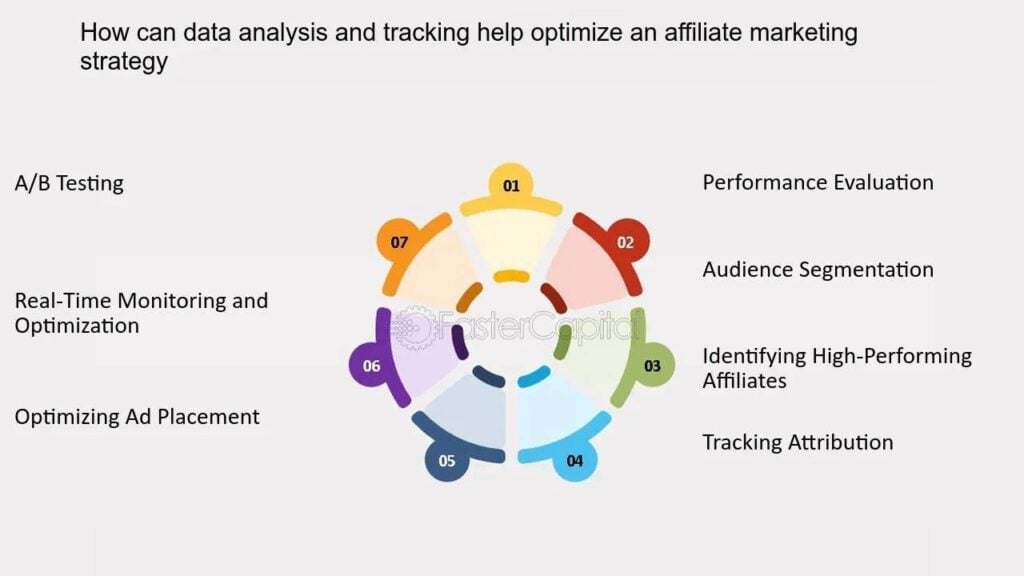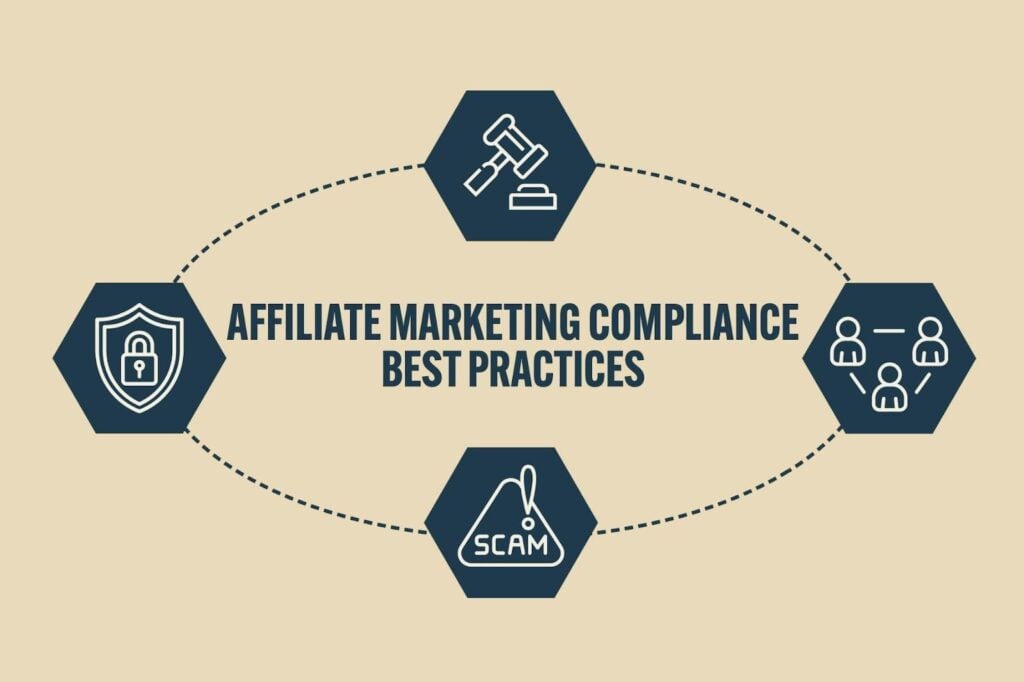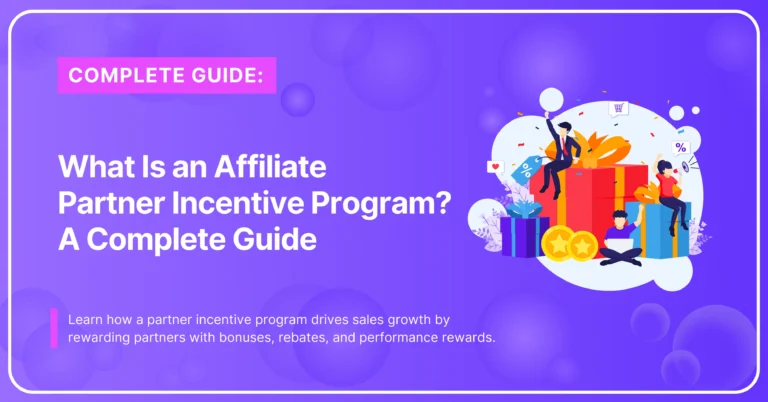Affiliate marketing is no longer a side hustle for bloggers—it has become a core revenue channel for global brands, SaaS companies, and e-commerce stores.
The model is simple: businesses tap into networks of independent partners (affiliates) who promote their products, and those affiliates earn a commission for every sale or lead they generate.

Make Money With AI
Join our Partner Programs!
Boost your reputation, drive revenue and grow your business with CustomGPT.ai.
The result? A win-win system. Businesses get scalable distribution without upfront ad spend, and affiliates get rewarded for driving results.
But here’s the catch: without proper management, even the best affiliate programs can quickly spiral into inefficiency, fraud, or poor brand alignment.
That’s where affiliate program management comes in. It’s not just about tracking sales—it’s about building a system that is transparent, fair, and optimized for long-term growth.
In this article, we’ll break down what affiliate program management really means, why it matters, and how businesses can run programs that scale without losing control.
What is an Affiliate Program?
At its core, an affiliate program is a structured partnership. A company provides affiliates with special tracking links, banners, or content to promote its product or service.
Affiliates then share those promotions through websites, blogs, social media, newsletters, or even private communities.
Every time a customer clicks through an affiliate’s link and completes a desired action (such as making a purchase, signing up for a trial, or filling out a form), the affiliate earns a commission.
There are a few common commission models you’ll see in affiliate programs:
- Pay-per-sale (PPS): Affiliates earn a percentage of every sale they drive.
- Pay-per-lead (PPL): Affiliates earn when they deliver a qualified lead (like a demo signup).
- Pay-per-click (PPC): Affiliates get paid for traffic, regardless of whether it converts.
Think of it as a performance-based digital salesforce: affiliates only earn when they deliver measurable results, making it one of the most cost-efficient ways for businesses to scale.

Why Affiliate Program Management Matters
Running an affiliate program may sound straightforward—set up tracking, offer commissions, recruit partners, and watch sales come in. But the reality is more complex. Without strong management, programs can face serious challenges:
- Fraud and abuse: Some affiliates use black-hat tactics like cookie stuffing, fake leads, or trademark bidding that hurt your brand and drain budgets.
- Poor alignment: Affiliates might promote products in ways that don’t match your brand voice, leading to customer confusion or even reputational damage.
- Wasted potential: Even well-meaning affiliates often underperform if they don’t get clear guidance, creative assets, or regular communication from the brand.
- Lack of tracking clarity: If performance isn’t monitored properly, businesses can’t know which affiliates drive real value and which are not contributing meaningfully.
This is why affiliate program management is critical. Done right, it ensures that programs deliver quality growth, compliance, and long-term partnerships instead of short-term wins.
Affiliate program management is not just about monitoring fraud or sending payouts—it’s about creating a structured ecosystem where affiliates feel supported, customers feel safe, and the business sees predictable ROI.
Core Elements of Effective Affiliate Program Management
So, what does effective management look like? A well-run affiliate program usually rests on a few core pillars:
1. Clear Policies and Guidelines
Affiliates need to know the rules of engagement. That includes what marketing methods are allowed (and which are banned), how commissions are structured, and what kind of messaging aligns with the brand.
Clear policies reduce disputes and protect brand reputation.
2. Recruitment and Onboarding
Finding the right affiliates is half the battle. Effective program managers don’t just accept anyone—they actively recruit partners who align with their brand values and target audience.
Then, onboarding should give affiliates the tools they need to succeed: tracking links, creatives, brand guidelines, and training resources.
3. Communication and Support
Affiliates aren’t “set it and forget it” partners. They need ongoing support. That means newsletters with product updates, seasonal campaigns they can tap into, and a dedicated channel (email, Slack, or platform messaging) for questions.
Strong communication keeps affiliates motivated and engaged.
4. Tracking and Attribution
Accurate tracking is the backbone of affiliate marketing. Managers must ensure clicks, leads, and sales are attributed correctly so affiliates are paid fairly.
A reliable tracking system builds trust and minimizes disputes.
5. Fraud Prevention and Compliance
Every affiliate program faces risks from fraudulent behavior—fake clicks, bot traffic, or unethical marketing tactics. Proactive monitoring tools and compliance checks help spot red flags early, keeping the program safe and credible.
6. Performance Optimization
The best programs don’t just monitor—they optimize. That means analyzing which affiliates drive the highest-value customers, experimenting with commission structures, and providing personalized guidance to help top performers scale further.
7. Payments and Recognition
Timely, accurate payouts are non-negotiable. Affiliates who don’t get paid on time lose trust and motivation. Beyond payments, recognizing top performers with bonuses, tiered rewards, or public shoutouts can strengthen loyalty.

Tools and Platforms for Affiliate Program Management
Managing an affiliate program manually—spreadsheets, emails, and endless checks—is inefficient and risky. That’s why most successful programs rely on dedicated tools and platforms to streamline operations, ensure accuracy, and scale effectively.
Here are the main categories of tools program managers use:
1. Affiliate Networks
Affiliate networks (like CJ Affiliate, ShareASale, or Rakuten) connect brands with a pool of affiliates. They handle tracking, payments, and reporting, making it easier for businesses to launch programs without building infrastructure from scratch.
The trade-off: networks charge fees and sometimes limit flexibility.
2. SaaS Platforms
Standalone affiliate management software (such as Impact, PartnerStack, or Refersion) gives businesses more control over their programs.
These platforms offer features like customizable commission structures, automated payouts, fraud detection, and deep analytics. They’re a good fit for brands that want flexibility and scalability.
3. Analytics and Reporting Tools
Affiliate managers often integrate analytics solutions (like Google Analytics or BI dashboards) to measure true performance—looking beyond clicks and sales to metrics like customer lifetime value (CLV) or retention rates.
This ensures the program rewards affiliates who deliver sustainable growth, not just quick wins.
4. Communication Tools
Slack groups, email campaigns, and even community hubs are often used to maintain strong affiliate communication. A well-supported affiliate is an active affiliate.
5. Fraud Detection Tools
Fraudulent activity—fake leads, bots, or unauthorized couponing—can drain revenue fast. Tools like FraudShield, Forensiq, or built-in platform features help identify suspicious patterns early.
The right combination of these tools depends on program size, industry, and business goals. But the principle remains the same: use technology to reduce manual work and focus on strategy.
Common Challenges in Affiliate Program Management—and How to Solve Them
Affiliate programs are powerful, but they’re not without hurdles. Here are some of the most common challenges managers face, along with strategies to overcome them:
1. Low-Quality Affiliates
Not every affiliate adds value. Some may generate junk traffic or chase commissions without caring about brand fit.
Solution: Be selective in recruitment. Define criteria for ideal partners and regularly audit performance to ensure affiliates contribute real value.
2. Compliance Violations
Affiliates sometimes break rules—intentionally or unintentionally—by bidding on branded keywords, spamming links, or using misleading claims.
Solution: Set clear policies, monitor activity, and enforce rules consistently. Automated monitoring tools can help spot violations before they escalate.
3. Tracking and Attribution Disputes
Affiliates often dispute commissions, claiming sales weren’t tracked or were unfairly credited to another partner.
Solution: Use reliable tracking technology and maintain transparent reporting. Offer clear explanations to affiliates on how attribution works (e.g., first-click vs. last-click).
4. Affiliate Inactivity
Many affiliates sign up but never actively promote the brand, leading to wasted time and resources.
Solution: Engage affiliates early with onboarding kits, regular updates, and campaigns they can plug into quickly. Incentives like first-sale bonuses can also help jumpstart activity.
5. Fraud and Abuse
Click farms, fake leads, and coupon hijacking can harm program integrity.
Solution: Implement fraud detection tools, manually review suspicious activity, and take swift action against bad actors.
6. Scaling the Program
As programs grow, managing hundreds (or thousands) of affiliates can feel overwhelming.
Solution: Automate repetitive tasks like payouts and reporting. Use segmentation to focus on top performers, and consider hiring dedicated affiliate managers as the program scales.
At its core, solving these challenges comes down to structure, transparency, and relationships. Programs that build trust with affiliates—and back it up with reliable systems—are the ones that thrive long-term.

Ensuring Compliance and Optimization
Affiliate program management isn’t just about driving sales—it’s also about protecting brand integrity and making sure efforts deliver long-term results.
Two of the most critical pillars of success are compliance and optimization.
Compliance: Protecting Trust and Brand Integrity
Without proper oversight, affiliate programs can quickly become vulnerable to unethical practices like click spamming, unauthorized coupon use, or misleading advertising.
These issues don’t just skew performance metrics—they can damage customer trust and expose businesses to regulatory risks.
That’s why modern programs prioritize compliance monitoring. Regular audits, clear policies, and fraud detection systems safeguard the brand while ensuring affiliates play by the rules.
Transparent communication also helps set expectations upfront, reducing the chance of disputes. A compliant program isn’t just safer—it also signals professionalism, building stronger partnerships with affiliates who value long-term trust.
Optimization: Driving Sustainable Growth
Once compliance is ensured, the next step is optimization. Effective affiliate program management goes beyond tracking clicks and sales—it’s about identifying what works best and doubling down on it.
Optimization includes:
- Performance Tracking: Monitoring metrics like conversion rates, customer lifetime value, and ROI to evaluate affiliate effectiveness.
- Resource Allocation: Focusing on high-performing affiliates while nurturing those with potential.
- Commission Refinement: Adjusting structures to better align with contributions across the customer journey.
- Testing and Iteration: Experimenting with new creatives, offers, or attribution models to unlock hidden growth.
The best programs treat optimization as an ongoing process rather than a one-time setup. By continuously refining strategies and learning from data, businesses can ensure their affiliate channels remain competitive and scalable.
The Balance of Both
Compliance and optimization may seem like opposite ends—one focused on control, the other on growth. In reality, they reinforce each other.
Programs that ignore compliance often waste resources on fraudulent activity, while those that neglect optimization miss opportunities to scale. The most successful affiliate ecosystems balance both, creating a channel that is trustworthy, profitable, and built to last.

Best Practices for Building a Thriving Affiliate Program
A well-structured affiliate program doesn’t just grow on its own. It requires strategy, consistency, and ongoing relationship management.
Here are some of the best practices top-performing brands follow:
1. Define Clear Goals and KPIs
Before launching, decide what success looks like. Is it customer acquisition, revenue growth, or brand awareness?
Setting KPIs—like conversion rate, average order value, or affiliate activation rate—gives the program direction and helps affiliates understand what’s valued.
2. Prioritize Quality Over Quantity
It’s tempting to recruit as many affiliates as possible. But a handful of high-quality affiliates will almost always outperform hundreds of low-engagement ones. Focus on building relationships with affiliates who align with your brand and audience.
3. Offer Competitive and Flexible Commissions
Commission rates directly impact affiliate motivation. Research your industry benchmarks and consider performance-based tiers (e.g., higher payouts for affiliates who exceed sales goals). This encourages sustained effort and rewards growth.
4. Invest in Affiliate Education
Affiliates are more effective when they fully understand your product, target audience, and brand voice. Provide onboarding guides, webinars, and promotional assets to empower them to succeed.
5. Maintain Consistent Communication
Affiliates should feel like partners, not contractors. Regular newsletters, Slack communities, and one-on-one check-ins help affiliates stay engaged and aligned with your goals.
6. Recognize and Reward Top Performers
Highlighting your best affiliates not only strengthens relationships but also motivates others. Leaderboards, exclusive bonuses, or spotlight features can turn affiliates into long-term brand advocates.
7. Continuously Optimize
Affiliate programs are not static. Track performance, test new commission structures, and adapt to shifts in consumer behavior. What works today might need fine-tuning tomorrow.
When executed well, these practices turn an affiliate program into a sustainable growth channel—not just a side experiment.
Future Trends in Affiliate Program Management
Affiliate marketing is evolving rapidly, shaped by AI technology, consumer behavior, and regulation. Here are some trends shaping the future of program management:
1. AI-Driven Insights
AI tools are making it easier to detect fraud, optimize commission structures, and predict which affiliates will deliver the most long-term value. Expect data-driven decision-making to play a larger role in affiliate strategy.
2. Greater Focus on Compliance
As governments introduce stricter digital marketing regulations, program managers will need to ensure affiliates follow not only brand policies but also privacy and advertising laws (e.g., GDPR, FTC guidelines). Transparency and auditability will be essential.
3. Shift Toward Micro and Niche Affiliates
Influencers with small but highly engaged audiences are becoming more valuable than massive publishers with broad reach. Brands will increasingly tap into micro-influencers who deliver authenticity and stronger conversion rates.
4. Integration with Broader Partnership Models
The line between affiliates, influencers, and strategic partners is blurring. Modern programs will likely evolve into partnership ecosystems that encompass content creators, agencies, and other collaborators.
5. Emphasis on Lifetime Value
Instead of rewarding affiliates solely for one-time sales, brands are starting to measure and incentivize affiliates based on customer lifetime value (LTV). This shift aligns affiliate incentives with long-term business health.
The future of affiliate program management is clear: smarter, more transparent, and more relationship-focused. Programs that embrace these trends will not only grow faster but also build resilience in an increasingly competitive digital landscape.
Frequently Asked Questions (FAQs)
What are the key components of an effective affiliate program management strategy?
A strong strategy includes clear goals, robust tracking, fair commission structures, and recruiting affiliates whose audiences align with your brand. Success also depends on providing marketing resources, monitoring compliance, and optimizing with metrics like conversion rates and lifetime value.
How do affiliate management tools improve tracking and compliance?
These tools provide real-time analytics on clicks, conversions, and revenue, while also detecting fraud such as click spamming or coupon abuse. They automate payouts, reporting, and attribution—making scaling easier, more transparent, and more secure.
What metrics should businesses track to measure affiliate program success?
Key metrics include conversion rate, average order value (AOV), cost per acquisition (CPA), return on ad spend (ROAS), and customer lifetime value (CLV). Tracking traffic quality and click-through rates also helps identify high-performing affiliates.
How can commission structures reflect affiliate contributions across the funnel?
Dynamic attribution models and hybrid commissions (flat fees + performance incentives) ensure affiliates are fairly rewarded for awareness, engagement, and conversions. Regular reviews of CLV and conversion rates keep payouts aligned with true impact.
What role do AI and blockchain play in affiliate program management?
AI automates recruitment, personalization, and performance analysis, while blockchain ensures secure, transparent tracking of clicks and payouts. Together, they strengthen fraud detection, trust, and scalability in modern affiliate ecosystems.
Conclusion
Affiliate program management is more than just running partnerships—it’s about building a transparent, compliant, and scalable ecosystem where both businesses and affiliates thrive.
By balancing compliance with optimization, brands can protect their reputation while unlocking new levels of performance. In a world where customer trust and measurable ROI define success, effective affiliate management isn’t optional—it’s essential.
For businesses ready to move beyond guesswork and turn affiliate programs into a true growth engine, the time to act is now.
Take the Next Step
Ready to apply these insights to your own business? Sign up for a free trial and start building a high-performing affiliate program today.
And don’t do it alone—join our growing Slack community to connect with other marketers, share strategies, and stay ahead of affiliate marketing trends.








